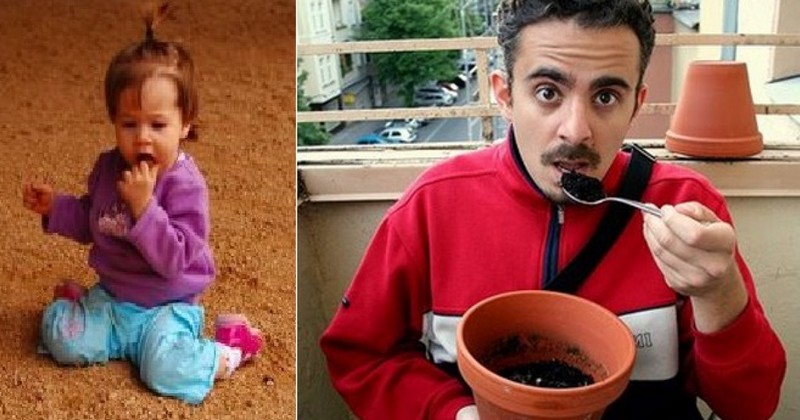Pica (alotrophagia): causes, symptoms and possible treatments

What is Pica syndrome and why is it such an unknown eating disorder?
There are different types of eating disorders, such as anorexia or bulimia. Although the latter are well known to most people, some of them are not so well known. One of these is the Pica syndrome o Alotrophagiaan eating disorder that affects mostly children.
Its main characteristic is that the sufferer feels an uncontrollable desire or impulse to ingest substances that are not nutritious, including dirt, ants, baking soda, glue, insects, paper, paperThese include dirt, ants, baking soda, glue, insects, paper, small pieces of plastic or wood.
Pica syndrome is associated with children with cognitive difficulties and other developmental disorders, e.g. autism. Up to 30% of children with this disorder have Pica. Although this behavior can be seen in other children at an early age, individuals with autism continue to engage in this practice at later ages.
- Recommended article: "10 signs and symptoms to identify Autism".
Pica syndrome: main characteristics.
Therefore, this disorder is characterized by a persistent craving that leads the person to want to eat substances such as dirt or paint. Substances that, in addition to containing zero nutritional value, cause the person with Pica to put their health at risk.
The Handbook of Clinical Child Psychology estimates that currently the prevalence of this disorder corresponds to between 4% and 26% of the institutionalized population. Some of the most frequent causes of Pica Syndrome are nutritional disorders, mental illness and psychological problems. However, in most cases the trigger for this behavior is not known.
However, it is important to treat this problem as soon as possible to avoid complications, it is important to treat this problem as early as possible in order to avoid complicationssuch as increased risk of gastrointestinal diseases and social maladjustment.
How is Pica syndrome diagnosed?
If there is suspicion that someone may have this disorder, an immediate medical evaluation is important to find out if there is anemia, intestinal problems or toxicity caused by ingested substances.. The doctor may use X-ray or Blood tests to determine the extent or consequences of such consumption.
In addition, the doctor may also perform a thorough evaluation for possible infections caused by battery-contaminated objects or substances. On the other hand, it is important to carry out a review of the patient's eating habits.
The presence of the psychologist is also important for a correct diagnosis.. It is essential to evaluate the presence of other disorders, such as mental retardation, developmental disorders or obsessive-compulsive disorder.
According to the DSM-V, the behavioral pattern of the person with Pica has the following characteristics:
- Persistent feeding of inappropriate substances must last at least one month for a diagnosis of Pica Syndrome.
- Feeding of non-nutritive substances is inappropriate for the individual's developmental level.
- Inappropriate eating behavior is not part of a cultural or social practice.
- If it occurs in the presence of another mental disorder (e.g., autism) or during a medical condition (e.g., pregnancy) it is serious enough to require independent medical attention.
Treatment and follow-up
Due to the high risk of medical complications (e.g. poisoning) associated with Pica, close medical supervision is necessary throughout the treatment of eating behavior.. Obviously, this treatment is not understood without the figure of a psychologist and / or psychiatrist expert in the treatment of eating behavior.
The Manual of Clinical Child Psychology emphasizes the application of cognitive-behavioral strategies due to their efficacy in the treatment of this type of psychopathology. For example, it is possible to train subjects to eat or not to eat harmful substances with the application of reinforcement techniques..
Complications associated with Pica Syndrome
As already mentioned, this disorder can lead to serious health problems.. Some of the complications associated with Pica Syndrome, are:
- Certain products such as paint may include toxic substances.and eating them can lead to poisoning. This can lead to serious complications, e.g. brain damage and even death.
- Ingestion of substances that cannot be digested (e.g. stones) can cause constipation or blockage in the digestive tract. (e.g. stones) can lead to constipation or blockage in the digestive tract, including the intestines. In addition, sharp objects can cause wounds in the mouth, neck or stomach.
- Ingested bacteria or parasites can cause serious infections that can damage the serious infections that can damage both the liver and kidneys.
- The existence of other psychological disorders may make it difficult to treat Pica syndrome.
Prevention
Pica syndrome usually begins in childhood and lasts only a few months. However, it is likely to be more difficult to manage in children who have developmental disabilities, as they may continue to show this behavior in later life. may continue to exhibit this behavior in later life..
But can this eating disorder be prevented? There is no specific way to prevent it. However, careful attention to the eating habits of young children and close supervision of children who are more likely to put things in their mouths can help prevent the disease before complications can arise.
As is always the case with this type of disorder, preventing this type of behavior from becoming part of a person's daily habits is critical, so the earlier intervention, the better. Once this behavior is consolidated, it is more complicated to make it disappear.
An irrational impulse
Pica Syndrome is an example of how, under certain circumstances, human beings are capable of embracing extremely harmful and maladaptive patterns of behavior that have no clear advantage. In allotrophagia, not only is the stomach filled impulsively, but the substances ingested are not nutritious and, in many cases, are toxic.In addition, the substances ingested are not nutritious and, in many cases, are toxic.
Understanding the psychological mechanisms behind the Pica Syndrome involves finding the mental processes that reinforce this "loop" of actions that is maintained over time, renouncing explanations based on the rational decisions of the patient.
(Updated at Apr 13 / 2024)